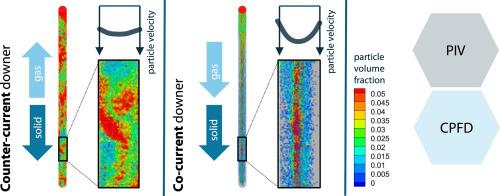用粒子图像测速法和计算粒子流体动力学对逆流和共流下行反应器进行对比分析
IF 5.5
Q1 ENGINEERING, CHEMICAL
引用次数: 0
摘要
我们使用颗粒图像测速(PIV)和计算颗粒流体动力学模拟(CPFD)研究了共流和逆流降井作业中的流体动力学。以流体催化裂化(FCC)催化剂和砂为原料进行了中试,验证了系统的稳定性,为模拟策略的验证提供了依据。通过PIV实验和CPFD模拟,比较了不同工作模式和条件下逆流和共流降温器的电抗器特性。PIV实验表明,与共流操作相比,逆流降压器的颗粒速度分布更均匀,梯度仅为最大速度的8%,而共流降压器的颗粒速度梯度比最大速度陡39.5%。仿真结果表明,与共流运行相比,逆流下行反应器的固含率提高了69%,停留时间延长了98%。因此,逆流下行电抗器的性能介于经典的共流下行电抗器和提升电抗器之间,为工业应用提供了灵活性。本文章由计算机程序翻译,如有差异,请以英文原文为准。

Comparative analysis of counter-current and co-current downer reactors using particle image velocimetry and computational particle-fluid dynamics
We investigated the hydrodynamics in co- and counter-current downer operations using particle image velocimetry (PIV) and computational particle fluid dynamics simulations (CPFD). Pilot-scale experiments were conducted for fluid catalytic cracking (FCC) catalysts and sand, which verified the system stability and provided the validation basis for the simulation strategy. We compared the reactor characteristics of counter-current and co-current downers under different operating modes and conditions using PIV experiments and CPFD simulations. PIV experiments showed that the counter-current downer exhibits a more uniform particle velocity profile, with a gradient of only 8 % of the maximum velocity, compared to the co-current operation, which shows a significantly steeper gradient of 39.5 % from the maximum. Simulations confirmed that the counter-current downer reactor has 69 % higher solid holdup and 98 % longer residence time than the co-current operation. Thus, the counter-current downer reactor demonstrated intermediate behavior between the classical co-current downer and riser reactors, offering flexibility for industrial applications.
求助全文
通过发布文献求助,成功后即可免费获取论文全文。
去求助
来源期刊

Chemical Engineering Journal Advances
Engineering-Industrial and Manufacturing Engineering
CiteScore
8.30
自引率
0.00%
发文量
213
审稿时长
26 days
 求助内容:
求助内容: 应助结果提醒方式:
应助结果提醒方式:


